|
|
Whalebone

|
|
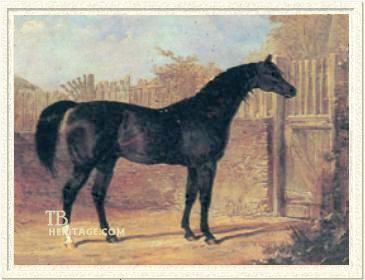 |
|
|
Whalebone established the most enduring and influential sire line in the Stud Book, the best son of a series of best sons descending from Eclipse; there could hardly be a pedigree today that does not include his name through his own sons and extending through his tail-male descendants, such as Stockwell, Bonnie Scotland, Teddy and Swynford.
"Bred in the Purple" from the great female family of Julia (1756, Family 1), his grandam, Prunella (1788), was by one of the most important sires and racehorses of the day, Highflyer. She produced classic winners and dams of classic winners, and the good runner Waxy Pope, who was nine times leading sire in Ireland. Her daughter, Whalebone's dam, Penelope (1798, by Trumpator) was a top racehorse who beat both colts and fillies during her five years of racing. Retired to stud, she was an exemplary broodmare who produced, in addition to Whalebone, his brother Whisker a good racehorse, sire of two classic winners, and excellent broodmare sire, and Woful, sire of two classic winners. Her daughters, in their turn, also became outstanding broodmares, particularly Whalebone's sister Web (1808), ancestress of Glencoe and Bay Middleton, among others, and Wire, who in Ireland, bred Verulam, a good runner and later sire of Wanderer, the 1855 Irish-bred Grand National winner. Wire established a tail-female line that included Uncas, a leading sire of steeplechasers in 1880s and Hilarity, who won over fences and was third dam of Ascot Gold Cup winner Santoi, a sire of good stayers and steeplechasers.
|
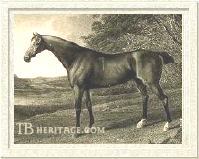
Penelope
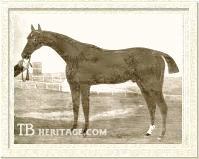
Waxy | |
Whalebone was the product of a highly successful breeding program at the Euston Stud in Suffolk, established by Augustus Henry FitzRoy, (3rd) Duke of Grafton. Grafton had used the Eclipse son Pot-8-Os (1773) with the female descendants of Herod in his stud, and then Pot-8-Os's son, Waxy (who he was finally able to purchase in 1808), who he bred repeatedly to both Prunella and her daughter by Trumpator, Penelope. This highly successful nick led to the Grafton stud's dominance in racing and breeding in the first quarter of the nineteenth century; twenty-six classic winners emerged from the Grafton stud between 1802 and 1831, many of them from Julia's descendants.
Whalebone's sire, the bay 1793 Derby winner Waxy, grandson of Eclipse and from a Herod mare, was a sucessful sire of sires and broodmares. Waxy was considered a horse of high quality, with a refined, Arab-like look to his chiselled head; Whalebone inherited his "high-bred nostrils and very prominent eyes," but was the smallest of the Waxy progeny, at 15 hands and 1/2 inch. His groom described him as "...the lowest and longest, and most double-jointed horse, with the best legs and worst feet I ever saw in my life." When in training, according to The Druid, "...his chief occupation was to rear and knock his hoofs together like a pair of castanettes." The Druid also described Whalebone as having "a rather Turkish pony look, and was broad and strong, with a shortish neck." |
Whalebone ran for four years, mostly over four miles and generally successfully, and as a racehorse he was universally considered honest, stout and true. At age three he won the Newmarket Stakes for colts in his first outing, and his second race, the Epsom Derby, beating nine other horses. Of his other starts that year, he lost once, a 200 guineas match at Newmarket, to Treasurer; won two 200 guineas matches at Newmarket Houghton on successive days, against Sir Marinel and then against Thorn; received a 60 guineas compromise in a scheduled match against Nuncio at Newmarket, took a walk-over for 375 guineas at Newmarket, and a 100 guineas compromise from Knave of Clubs and Florival at Newmarket.
In 1811, age four, he won the King's Plate at Newmarket, beating Burleigh and three others, collected forfeits in three scheduled races at Newmarket; ran second to Florivel in Newmarket's Trial Stakes; and lost a match against Discount at Newmarket and also lost a 50 guineas sweep at Huntingdon, and paid a forfeit to Wizard at Newmarket. At age five, 1812 he won the King's Plate at Newmarket First Spring, beating Teasdale (1807), and a £50 purse at Newmarket July, after which he was purchased by Robert Ladbroke, a wealthy banker who was a member of the fast set surrounding the Prince of Wales, which included Grafton's son, the fourth Duke. In the remainder of that season, Whalebone won the 3-1/2 mile Gold Cup at Northampton, a 200 guineas match against the colt Turner (by Lignum Vite) at Newmarket, and a 200 guineas match against the 1808 Derby winner, Pan. He had two losses that year, a match against Bolton at Newmarket Craven, and a 300 guineas sweep at Newmarket First Spring, won by Trophonius. In 1813, now age six, he wasn't sent to Newmarket, but to country meets, all of which he won: the 4 mile heats King's Plate at Guildford, and the King's Plate and Ladies' Plate at Lewes.
Whalebone in the Stud
Ladbroke's bloodstock were auctioned at an 1814 sale conducted by Tattersall's; considered an unlikely candidate as a fashionable stallion, due to his size, he was purchased for 510 guineas by George O'Brien Wyndham, (3rd) Earl of Egremont who initially tried to keep him in training (Derby winner Octavius was purchased by Egremont at the same sale for 630 guineas), but gave it up and sent Whalebone to his stud at Petworth, where he began to produce a succession of winners and was leading sire in the years 1826 and 1827.
He was considered a source of stamina, more than speed, and this ability tended to span generations. He often passed on his smallish-size, his sturdy build, long back and short legs.
His classic winners included the Derby-winning full brothers LAP-DOG (1823) and SPANIEL (1828) and Oaks winner CAROLINE (1817). Neither Lap-Dog nor Spaniel had much of an influence in the stud, but Whalebone's sons, CAMEL and SIR HERCULES became the principal conduits through which the sire line continued; Camel, when he sired the enormously successful Touchstone, and Sir Hercules through his son, Birdcatcher (grandsire in tail-male of Stockwell, the "Emperor of Stallions"). Whalebone also sired DEFENCE, a horse that raced once, but had a terrific influence on French breeding by getting the dual-Gold Cup winner, The Emperor, who was imported to France in 1850, where he sired the important stallion Monarque. Another son, Waverley, was the fourth son to establish a fairly long-lived branch in tail-male. Whalebone's daughters "lost speed early," and with few exceptions were not good on the turf.
CAMEL (1822) was bred by Egremont from a mare by Selim. Camel won a few races, including the two mile Port Stakes. A stocky, short-legged horse, his most distinctive features were his powerful quarters and thighs. He got a few other moderately successful horses, but it was Touchstone's success that made him a popular sire. |
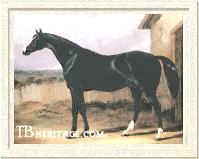
Camel
| |
The contemporary turf observer, The Druid, noted, "This horse [Camel] was as good as an annuity of 800 pounds [sterling] to Mr. Theobald [his second owner] for several seasons after the performances of Touchstone had brought him so prominently into notice..." While in the possession of Egremont, he spent the 1830 season at the Grosvenor Eaton stud, which was when he got Touchstone on Banter. After that, he was sold to William Theobald, and stood thereafter at Theobald's Stockwell Stud near Clapham. Next to Touchstone, Camel's best son was Launcelot, a full brother to Touchstone, who won the Champagne Stakes at age 2 and at age three placed second for the Epsom Derby and then went on to win the St. Leger, narrowly beating the better horse, Maroon.
|
|
Whalebone's best sire son was SIR HERCULES (1826), who was a good juvenile in Ireland and won the Claret Stakes at Newmarket Craven in 1830. In Ireland, he got Birdcatcher, ancestor of Sterling, Swynford and that branch of the Eclipse line, and also was grandsire of Stockwell, "the Emperor of Stallions," and his brother Rataplan (1850), who won forty races, including the Ascot Cup and Doncaster Cup. Rataplan was born on the day his breeder, Mr. Theobald, whose long-term faith in the Whalebone sire line was well-rewarded, died. |
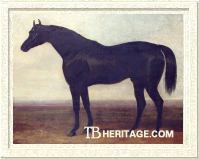
Sir Hercules | |
SIR HERCULES also got Faugh-a-Ballagh, sire of Leamington, exported to the U.S., who had an impact as a sire there for several generations. Sir Hercules daughters included three good mares, Maria, Waterwitch and Cruiskeen, all bred in Ireland. An English-bred son of Sir Hercules, Gemma-di-Vergy, became an important sire in Ireland. Sir Hercules also had an influence on steeplechasers: his daughter, Brunette (1834) was an oustanding jumper in Ireland; Arthur (1833) ran second in the Grand National Steeplechase at Aintree, and later was broodmare sire of the dual winner of that race, The Lamb; another Sir Hercules son, The Hydra, was broodmare sire of Emblem and Emblemataic, sister who each won the Grand National. |
Whalebone's son DEFENCE (1824), from Defiance (by Rubens) was "rather thick and cobby-looking," with a plain head, a short back and broad chest with "splendid" shoulders, standing "a trifle" under 15.2 hands. He was bred by Oxford livery stable owner Isaac Sadler, a confederate of the Day brothers, who had farms at Northleach, near Cheltenham, and at Stockbridge. Defence's dam, Defiance, had been bred by Saddler, and was an outstanding producer: bred to Reveller, she produced an excellent race filly in Delight; bred to Tramp, she produced 1833 Derby winner Dangerous (who broke down during the running of it, or soon thereafter), and two sisters to Dangerous, Design (1827) and Device (1826) who were runners and later producers for Sadler.
DEFENCE broke down in his first race, the Derby, but became another source of stamina at stud.
DEFENCE'S son, the in-bred The Emperor (out of a Reveller daughter of Design's (by Tramp), won the Ascot Gold Cup (for a few years called the Emperor of Russia's Plate) twice, in 1844 and 1845. At age nine he was purchased by the French National Stud and sent to France, where he was proved a great success as a stallion. The Emperor sired the promising Lindor (1852), who broke his leg in the running of the Prix du Jockey Club; Allez-y-gaiement (1852), who won the Grand Criterium as a juvenile and at age three the Prix du Conseil (Moulins); Baroncino, winner of the Poule d'Essair and the Prix de l'Empereur, and second in the Prix du Jockey Club, and a host of other winners, many of which bred on. He was also the probable sire of Monarque (1852) -- the champion at age three in France, winner of the Prix du Jockey Club, the Grand Saint Leger de Moulins, and a number of other races (including five at age four), and later an extremely influential sire -- and of Peu d'Espoir, winner of good races at ages two and three, and four, including a famous match against Ronzi, run in four heats. Monarque was the sire of the French-bred English Triple-Crown winner Gladiateur (1862).
|
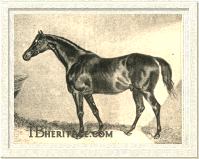
Defence | |
In addition to The Emperor, DEFENCE'S sons included Barrier, who won the Molecombe Stakes and the Sussex Stakes at Goodwood; Bulwark, who won the July Stakes at Newmarket and other races; Tipple Cider, Palladium, and other good winners. His daughters were as good as his sons on the turf: Deception won the Oaks in 1839 and ran second to Bloomsbury in the Derby that year; Barricade (sister to Barrier) won Goodwood's Sussex Stakes; Benedetta won Newmarket's Hopeful Stakes; Decision won Goodwood's Molecombe Stakes, and Decisive won several races, including a big purse at Stockbridge. |
DEFENCE was an outstanding broodmare sire, whose daughters produced four classic winners. An unnamed daughter produced Andover (1851), by Bay Middleton, who won the Derby in 1854. Two other Derby winners from his daughters were Caractacus (1859, from Defenceless and by Kingston) and Epirus). DEFENCE'S daughter Southdown produced Alarm (1842, by Venison), a stayer with speed and later a useful sire; Southdown's daughter bred the good Newminser colt, Cambuscan, later sire of the unbeaten Kincsem. The 1847 Oaks winner, Miami (1844, from Diversion and by Venison), was out of another Defence daughter; Miami is at the head of Family 5 - j, from which descend (in tail-female) English Triple Crown winner Galtee More, Derby winner Ard Patrick, and the classic winner and sire Djebel. DEFENCE'S daughter Grace Darling was dam of The Hero (by Chesterfield, a son of Orville), who won the Doncaster Cup twice. Other daughters included Dauntless, produced Cesarewitch winner Haco (1850, by Old England), and another (unnamed) daughter produced Cesarewitch winner Mr. Sykes (1850, by Sir Tatton Sykes).
Whalebone's son WAVERLEY (1817, out of Margaretta, by Sir Peter Teazle) was the fourth son through whom Whalebone's sire line continued, although it was in America and not the England, that it flourished. He was bred at Petworth by Lord Egremont, and was the best of his dam's offspring. He was sold to John George Lambton, a Durham sportsman who later became the first Earl of Durham; he owned some classic winners and was the principal of the Lambton Hunt. In 1821 the Hunt established its own race meeting at Lambton Park, which became one of the premier social events of the northern turf. Lambton built training grounds and stables next to the park, where Waverley and other runners took up residence, but the entire affair was somewhat short-lived, when Lambton gave up racing and sold his stables due to ill-health in 1826. Waverley appears only to have run in the north. At Durham he ran second to Fair Helen for a silver cup over two miles at age three, beating the future Great Yorkshire Stakes winner Borodino (also owned by Lambton), and at age five he won the Newcastle Cup, beating Richard (by Orville) and Fair Helen, and the Pontefract Cup, beating Euphrates and four others.
WAVERLEY proved to be a good sire. His son, The Saddler (1828, from Castrellina by Castrel), won the York St. Leger and the Doncaster Cup, and later got a classic-winning daughter, Sorella (One Thousand Guineas, Park Hill Stakes, and other races), Sylvan (Manchester Cup), The Provost (Scarborough Stakes, Northallerton Gold Cup, Gold Cup Stakes at Catterick Bridge, King's Plate at York August, Four Year Old Stakes at Doncaster, second to Bee's Wing in the Doncaster Gold Cup), and the long-running great four mile mare Inheritress, from whom descended a number of top runners in France and Germany (Family 4 - b). The Provost later sired Hybla, dam of Oaks winner Mincemeat.
WAVERLEY also sired Don John (1835, out of a mare by Comus), who won the 1838 Doncaster Cup and the St. Leger, and in the stud got Doncaster Cup winner The Ban, Oaks winner Lady Evelyn, and other good winners, and some good producing daughters, including Lady Evelyn (heads the branch of Family 2 - g), Maid of Masham (head of branch Family 9 - e), and Castanette, dam of Doncaster Cup winner Fandango (1852). Don John also sired Iago (1843), whose son, Bonnie Scotland (1853), who was sent to the U.S. and established the American sire dynasty through Ben Brush.
Another Waverley son, Locomotive, won the Gold Cup at Heaton Park, beating Derby winner Mundig and other good horses.
LAP-DOG (1823) was Whalebone's first Derby winner. His dam, a mare by Canopus, was a reliable producer for Egremont. She was bred to Octavius once, in 1817, producing a filly the following year, and after that was bred exclusively to Whalebone. Lap-dog was her fifth foal, and Whalebone's only other Derby winner, SPANIEL (1828) was her seventh youngster. She also produced SAXON (1822), TWATTY (1819), FANCHON (1827) and LAPWING (1826). Lapwing was sent to Ireland, where he became the sire of St. Lawrence (1837), a very successful runner in Ireland (Corinthian Stakes, Royal Whip, five Queen's Plates, and four other races) and a successful Cup and Plate horse in England, winning the Chester Cup over 29 runners when he was age ten). Twatty, who ran unsuccessfully in the Oaks, was later third dam of the good cup horse, Tim Whiffler. Fanchon became the dam of One Thousand Guineas and Criterion Stakes winner Cara (1836, by Belshazzar).
Lap-dog was raced by Egremont, and at age three won a 50 sovereign purse at Newmarket Second Spring, beating Lamplighter, Recruit, and eight others, this serving as a prep race for the Derby, which he won, at odds of 50 to 1, beating eighteen others. In October at Newmarket, he was easily beaten by Lamplighter in a 100 sovereign races, although he came in ahead of the Two Thousand Guineas winner, Dervice. Retired to stud, in England, he got Esperance, the dam of Espoir (1841, by Liverpool), who produced Oaks winner Brown Duchess and Park Hill Stakes winner Battaglia.
In 1835 LAP-DOG was purchased by James Jackson of Alabama and imported into the U.S., and stood first at Thomas Alderson's stable in Nashville for a $50 fee, and then at the Lincoln County, Tennesse stud of Jackson's confederate, Colonel George Elliott. He was not well-patronized, posssibly due to bad-mouthing by the connections of the stallion Lutzborough, who was standing nearby, and he died in 1838.
|
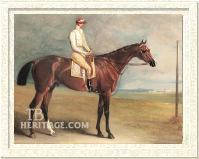
Spaniel | | Lap-Dog's brother, SPANIEL (1828), resembled his sire, Whalebone, in that he was a small, long horse. He was a weedy youngster, and was sold to Lord Lowther for 150 guineas as a yearling and placed in training with Joe Rogers. He debuted at Newmarket in a sweepstakes over the Two Year Old Course (almost 3/4 of a mile) for juveniles, and ran second to Zany in a field of seven. He failed to place in Newmarket's July Stakes, and in a £50 juvenile race in October, both also over the TYC, and then ran third the Nursery Stakes (carrying 7 st.-12 lb to the 8 stone plus carried by the other four runners) over the Ditch Mile in October.
|
At age three, he came out to win a handicap sweepstakes for youngsters over the Abingdon Mile, the most lightly weighted of the field of fourteen, some of them two year olds. He next ran in and won the Shirley Stakes for three year olds, over a mile, beating three other youngsters. Then came the Derby, which SPANIEL entered in perfect condition, "his coat was silk itself, and he trod the turf as though he disdained the earth and trod on air." Two Thousand Guineas winner Riddlesworth was favored to win, but his owner, Lord Jersey, declared to win with another colt, and with Riddlesworth held back, Spaniel won easily over a field of twenty-two other youngsters. He ran two more races that year, placing second to Camarine in the Trial Stakes, and, in November, unplaced in the Audley End Stakes, won by Lucetta.
He was a sturdy, honest runner, but he raced in years when horses like Camarine, Lucetta, Tranby and Priam were on the turf, and, the next season, after failing to place in Newmarket's Oatland Stakes and a 1-1/2 mile plate on Ascot Heath, he was sent to run at Hampton, where he won the Gold Cup. After this he was sold to Mr. Meyrick, who took him to Wales, where he ran in company and at distances more suited to him: he won a plate at Brecon over two miles, the Tradesmen's Plate (2 miles) and the Dynevor Stakes at Carmarthen, and the Members' Plate (2 miles) and a handicap (1-1/2 miles) at Brecon in the fall. The next year he broke down, running the first heat of the CanterburyStakes, and died soon after. |
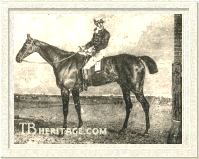
Longwaist | |
LONGWAIST (1821), a bay colt bred by retired jockeyTom Goodisson, was sold to Fulwar Craven, who ran him at age three, and then sold him for 3,000 guineas to John Mytton, who ran him successfully for two years. He ran for two more years after being purchased by Alexander Nowell for 860 guineas, after which he was retired to Nowell's Underley Stud. He was out of the Dick Andrews daughter, Nancy (Family 9 - c), an excellent producer who was also the dam of dual Doncaster Stakes winner Muley Moloch, the sire of Alice Hawthorn; Nancy was also, through daughter Muliana (1831, by Muley), tail-female ancestress of a host of good producers and winners, including Lady Josephine and all the outstanding winners that descend from her. |
LONGWAIST was an extremely good runner and stayer, most of his races over three and four miles. His wins at age three included the Coronation Stakes at Stockbridge, the St. Leger Stakes at Winchester, the Glochestershire Stakes at Cheltenham, the Wiltshire Stakes at Salisbury, and other purses, including a walk-overin Bath's Kelton Stakes; at age four he won the Craven Stakes and the Oatlands handicap at Newmarket, and the Cups at Winchester, Cheltenham, Oxford ( a walk-over), Burderop, and Warwick, running second for the Ascot Gold Cup (beaten by Bizarre) and the Doncaster Cup (beaten by Lottery). Sold to Mytton, in 1826, he won the Newton Gold Cup and the Warwick Cup, and several sweeps, and placed second in the Cheltenham Gold Cup, the Lichfield Cup, and the Stand Plate at Chester, but he was not the horse he had been at ages three and four; at the end of the season he was sold to Nowell. In 1827 he beat the good race mare Fleur-de-Lis at Manchester, and won the Newton Cup and the Lancaster Cup, not placing in the Doncaster Cup, his only other race that year. In his final season, 1828, he won the Cup at Newton, the Preston Cup, and walked-over for the Lancaster Cup, and at Doncaster, placed second for the Cup, beaten by the four year old Blacklock son, Laurel. He ran one more race, unplaced, that year, and was retired to the Underley Stud, dying at age fourteen, when he hit his head on a stable doorway.
He was best as a filly sire. His daughter, Louisa, won a juvenile sweepstakes at Ascot, beating the good filly Pussy and three others, and was second to Pussy in both the Epsom Oaks and the Ascot Derby, and second to Glencoe in the Racing Stakes the following year. His daughter Cestus (1830, out of Lacerta, Family 11 - c) was tail-female ancestress of Atherstone and St. Germain, and daughter Solace (1830, out of Dulcamara, Family 12 - a), the dam of Manchester Cup winner Aristotle, produced a daughter, Secret (1841), third dam of the influential sire, Sterling, his brother, Cambridgeshire winner Playfair, and a daughter, Granite, whose descendants have been winners through the 20th Century. |
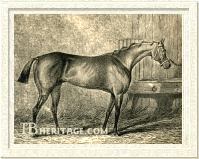
Chateau Margaux | |
CHATEAU MARGAUX (1822), from the Gohanna daughter, Wasp, was a brown colt bred at Petworth, who initially ran as "Brother to Addy." Like other Whalebone sons, he was a stayer and a weight-carrier, although he had speed enough to run second in the Two Thousand Guineas in 1825, his first outing, and, in Egremont's colors, ran in top company, besting many classic winners. That year he also won a 100 sovereign match against LIONEL LINCOLN, also by Whalebone, but he ran unplaced in Memnon's St. Leger, his only other start that year. At age four, his wins included the Claret Stakes, the Ascot Gold Cup, the Brighton Gold Cup, and some four-mile King's plates and other races. He ran until 1828, winning a twenty-two of twenty-eight stakes and plates, overall.
|
He was a moderately successful sire in England; his best was probably daughter, Queen Bess, which won the 1833 Champagne Stakes, and the following year won both the Croxteth and Stanley Stakes at Liverpool, and ran second to Touchstone in Chester's Dee Stakes and in the Palatine Stakes at the same meeting. A son, Hock, was a good runner, second in the Lewes Stakes to Elis; a daughter, Falernia (1830), ran second in the One Thousand Guineas; and daughter Helga, was second to Pussy in the King's Guineas at Newmarket. One of his unnamed daughters (1832, out of a Cervantes filly) heads Family 2 - e, from which many good sires and winners descend.
In 1834 he was imported into the U.S. by the Virginia-based bloodstock company, Merritt & Co., where he proved to be a good stallion. CHATEAU MARGAUX'S sister, Addy, was second dam of the in-bred 1859 Grand National winner, Half Caste, who was by Morgan Rattler (1836, by Blacklock son Velocipede), a son of MRS. BANG-UP (1825, Family 2 - t), a Whalebone daughter bred at Petworth and sent to Ireland.
|
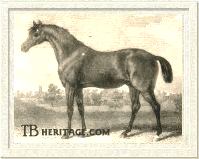
Flexible | | FLEXIBLE (1822) was bred at Petworth and sold as a yearling to a Mr. Bartley, who soon therafter sold him to John Mytton, who owned LONGWAIST. FLEXIBLE was out of Themis, a Sorcerer daughter, and true to his breeding, was a good distance horse. At age three he won a match at Epsom, beating Velasquez, followed by a win of the Original Stakes at Bath. He placed second to Mephistopheles in the St. Leger Stakes at Cheltenham, and at the same meeting won £75 in a race against six other mostly older horses, but could only run third in the Cheltenham Cup, won by Longwaist, who was still owned by Fulwar Craven. He went on to win the Stourbridge Cup, the Town Plate (in two-mile heats) at Warwick, and Shrewsbury's St. Leger Stakes; he also ran second for Warwick's St. Leger Stakes, beaten by Doctor Faustus.
|
At age four, FLEXIBLE came out at Chester, running second to Brutandorf in the Cup; he failed to place a few days later in the Stand Cup. In his next race, at Manchester, he ran third for the Cup to Signorina and Memnon. Back at Cheltenham, he won the Sherborne Stakes, but failed to place in the Glocestershire Stakes. His only other win that year was the Darlington Cup at Wolverhampton, and he placed second to Grenadier in the Cup there. In 1827, age five, he ran twice at Cheltenham, injuring himself, and he was retired to stud, sold to Mr. Bach of Bromfield. He was not of much use as a stallion.
There were some other Whalebone sons of note. CETUS (1827) from Lamia, by Gohanna, won the Ascot Gold Cup, Criterion Stakes, Warwick's Produce Stakes, and three rich produce stakes. He was imported into the U.S. by F.P. Corbin of Virginia in the early 1830s, but did not have an impact on racing bloodlines. THE SEA (1830), from Orville daughter Mermaid, became a steeplechaser, and was ridden by his owner, the Irish sporting lord, Henry, Marquis of Waterford, in the 1840 Grand National at Aintree (the year so many horses came to grief at the wall or into the adjacent stream (named that year as Valentine's Brook for the debacle there)). In the stud he got Freetrader (1849, out of Miss Cobden, who was a Blacklock grandaughter), who won the Grand National in 1856. STUMPS (1822), was another good four-mile horse which won the Goodwood Cup, the Brighton and Goodwood Stakes, the Trial Stakes, the Town Plate, King's Plates and numerous other races at Newmarket and elsewhere; he later sired John Gully's Viator, winner of Newmarket's Riddlesworth Stakes. GABERLUNZIE (1824) won a match against BROCARD at Newmarket, at age three. Isaac Day's promising colt, SHARK, won the 1831 Hereford Gold Cup, but broke his leg during the running of the Goodwood Stakes in 1832, and had to be destroyed. The grey colt THE EXQUISITE (1826) was second to Frederick in the Epsom Derby of 1829.
Whalebone's daughters had some success on the turf, and many became the ancestresses of a number of excellent racehorses. His best distaff runners were Caroline and Brocard. Oaks winner CAROLINE (1817, Family 23 -a), was from the exceptional producer Marianne (1798, by Mufti), who also produced 1812 Derby winner Octavius and two Woodcote Stakes winners, Scrub and Hamlet. Caroline also won some King's Plates and ran second in the July Stakes and the One Thousand Guineas. Her descendants bred on until the mid-nineteenth century. |
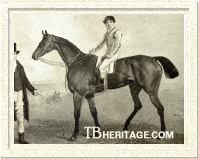
Brocard | | BROCARD (1824, Family 22) was a beautiful bay filly out of the Selim mare, Varennes, a sister to Sorcerer son Merlin, bred by the Earl of Verulam. She was a top-class filly that ran for three years. Her wins included her first race at age three at Newmarket Craven, a 200 sovereign sweep, beating four colts, followed by two more wins in sweeps at the same meeting. She did not place in Gulanre's Oaks, but took a walk over for Ascot's Albany Stakes, and ran second to Pastime in the Oatlands Handicap. She also beat the good Partisan son Amphion in a match at Newmarket Houghton, receiving 6 pounds from the colt.
|
At age four, 1828, she won Ascot's Swinley Stakes, beating the One Thousand Guineas winner, Zoe and one other in a canter; the Wokingham Stakes, beating seven horses and mares, and ran a dead-heat with the good racer Glenartney in the Audley End Stakes, dividing the winnings. She also ran second to the good horse Rapid Rhone in Newmarket's Claret Stakes, and second to Rough Robin in the Garden Stakes at Newmarket later in the year; she ran in, but did not place in the Ascot Gold Cup. At age five she won two matches against inferior animals, Carthusian and John de Bart, both run at Newmarket. She also ran third in the Oatlands, won by Cadland, and failed to place in Newmarket's Craven Stakes, her first outing that season.
Two of her daughters were good producers: Concertina (by Actaeon) became the dam of King Edward Stakes winner Musician, and Corumba (by Filho-da-Puta) was second dam of Cambridgeshire and Cesarewitch winner Rosebery and his half-sister, Grand Duchess (Family 22 - d) from whom such horses as Yours (1894, dam of Oaks winner Our Lassie and St. Leger winner Your Majesty), Arc winner and sire Parth, Two Thousand Guineas winners Mr. Jinks, and the great producer Waffles (1917, dam of Derby winner Manna and St. Leger winner Sandwich) descend in tail-female.
Lord Verulum also bred and raced the bay VESTRIS (1828), a brother to Brocard, who won several rich stakes as a three year old, including 850 sovereigns at Ascot, 650 sovereigns and Goodwood, and the Column Stakes at Newmarket. He later sired a Grand National Steeplechase winner, Mathew. |

Rachel

Moses | | Whalebone's daughter RACHEL (1823, Family 5 - b), out of a Gohanna daughter, and sister or half-sister to Derby winner Moses, won Newmarket's rich Oatlands Handicap at age three, both Rachel and Moses owned by the Duke of York. She produced a number of foals in the Hampton Court Stud, including the Sultan son, Hampton, before being sold to the French Government and sent to France in 1837. MOSES, who won the Derby, is listed in the GSB as by "Whalebone or Seymour," although some turf writers stated he was generally accepted to be by Whalebone.
NAIAD (1828), out of the Orville daughter, Mermaid, was a sister to THE SEA. She won Newmarket's Nursery Stakes as a juvenile, beating Spaniel and Lavant Stakes winner Conciliation. Sent to France in 1834, she became the dam of three classic winners, the bay colt Vendredi (by Cain), winner of the Prix du Jockey Club, and Nativa (1840) and Dorade (1843), both by Royal Oak, both of which won the Prix de Diane. Nativa, who also won the Prix du Cadran, later became the dam of French One Thousand Guineas winner Nancy (1851) and French Two Thousand Guineas winner Nat (1853), both by Mr. Wags.
|
CORSET (1829) won a handicap sweepstakes over Newmarket's Two Year Old Course, beating five other youngsters. The grey DANDIZETTE won Newmarket's Oatlands handicap in 1824, and ran second to Elfrid in the Brighton Cup in 1823, beating some good runners; her female line bred on until the early 20th century. NORNA (1818), a sister to WAVERLEY, won the Epsom Cup in 1822.
TWATTY (1819, Family 3), sister to Lap-Dog and Spaniel, ran second to Mirandola in a handicap at Newmarket; she later became tail-female ancestress of the good runner Tim Whiffler (1859), winner of the Doncaster Cup, Chester Cup, Goodwood Cup and other races. Another full sister to these horses, FANCHON (1827), became the dam of One Thousand Guineas and Criterion Stakes winner Cara (1836, by Belshazzar), from whom the great South American runner Yatasto (1948) and the top Japanese colt Ten Point descend.
BALEINE (1830, Family 8 - b), out of a Sorcerer mare, beat the future Oaks winner Pussy in a match for 100 sovereigns at Goodwood in 1833. In the stud she produced a good race filly in Physalis (1841) and several other daughters that bred on. A highly successful family descends from her daughters, which included the good runners Rapid Rhone (1860) and Stafford (1861), Prix de Diane winners Fregate, Presta, Destinee, and Belle Sicambre, and more recently Derby winner Phil Drake, Grand Prix de Paris winner Danseur and his sister Prix de Diane winner La Sega, second dam of Prix du Jockey Club winner Top Ville.
MYRRHA (1830, Family 10), out of the Young Gohanna mare, Gift, is seen in pedigrees because her tail-female grandaughter was Queen Mary (1843), who in turn bred Blink Bonny (1854, dam of Caller Ou and Blair Athol), the influential American sire Bonnie Scotland (1853), Broomielaw and Haricort, among others.
The bay BUSTLE (1827), from the Quiz daughter, The Odd Trick, was sent to the U.S., where she was influential in early American pedigrees; Banastar (1895, Brooklyn Handicap winner), Vincentive (1940, Dwyer Handicap) and John William (1957, Withers Stakes) descend from her. Her sister, TRICKERY (1830), produced Minotaurus, who won the Union-Rennen in Germany. A three-quarter sister to these two mares, Misdeal, by Camel (1839), won the St. James's Palace Stakes, and Misdeal's sister, Revoke, was fourth dam of Mrs. Veal (1890), who became a good producer in South Africa.
Many of Whalebone's daughters bred on, and are more distant ancestresses in tail-female descent of such horses as English Triple Crown winner Isinglass and Belmont Stakes winner Nashua (ANTIOPE, 1817, Family 3). Oaks winner Tormentor, Derby winner Petrarch, and 1978 Doncaster Cup and Irish St. Leger winner Protection Racket, all descend from ALEA (1828, Family 10; she ran unplaced in the Oaks). Alea's unnamed sister (1831) was the dam of two winners of the Union-Rennen in Germany, Lionel and Uriel, and their sister, Amelie, produced two more winners of that race.
-- Patricia Erigero
|
|
|
|

